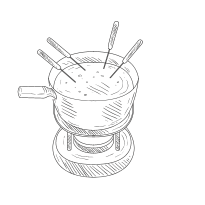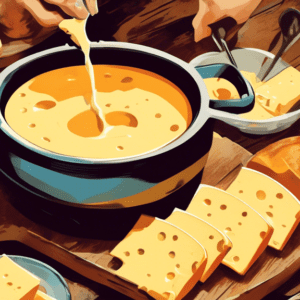Indulge in Creamy Deliciousness: A Step-by-Step Guide to Effortless Cheese Fondue
Introduction: Unveiling the Simplicity of a Classic
Cheese fondue, a culinary masterpiece originating in the Swiss Alps, evokes images of cozy gatherings and delightful dipping experiences. Often perceived as a complex endeavor, we’re here to debunk the myth and guide you through crafting an unforgettable fondue feast with ease. Whether you’re a seasoned chef or a kitchen novice, our comprehensive guide will empower you to create a pot of irresistible, velvety smooth fondue that will have your guests clamoring for more.
1. Gathering Your Fondue Arsenal: Essential Equipment for Success
Before embarking on your cheese fondue adventure, equipping yourself with the right tools is paramount. Fear not, you won’t need a fancy arsenal of specialized equipment. In fact, chances are you already possess most of what you’ll need. Here’s a rundown of the essentials:
1.1. Fondue Pot: The Heart of the Operation
The fondue pot, also known as a caquelon, serves as the central stage for your cheesy masterpiece. These pots are typically made from ceramic, cast iron, or stainless steel, each offering unique heat retention properties. For optimal results, we recommend a heavy-bottomed pot to ensure even heat distribution, preventing scorching and ensuring a consistently smooth fondue experience.
1.2. Fondue Forks: Your Dipping Companions
Fondue forks are specially designed with long handles and two or three prongs, perfect for dipping bread cubes, vegetables, and other delectable morsels into the molten cheese. Opt for forks with heat-resistant handles to protect your hands from the heat emanating from the pot.
1.3. Heat Source: Keeping the Fondue Flowing
To maintain the perfect fondue consistency, a reliable heat source is crucial. You can choose from a variety of options, including a tabletop burner, a portable gas stove, or even a chafing dish. The key is to select a heat source that provides a gentle and consistent heat, preventing the cheese from burning or becoming overly thick.
1.4. Additional Essentials: The Supporting Cast
In addition to the core equipment, a few supplementary items will enhance your fondue experience:
- Cutting board and knife: For preparing your dipping ingredients.
- Serving platters and bowls: For presenting your fondue accompaniments in an organized and visually appealing manner.
- Small plates and napkins: To provide your guests with a hygienic and enjoyable dining experience.
2. Selecting the Perfect Cheese: The Foundation of Flavor
The cheese selection is arguably the most critical aspect of crafting an exceptional cheese fondue. While countless cheese combinations exist, certain varieties lend themselves exceptionally well to the fondue pot. When making your selections, consider factors such as melting point, flavor profile, and how well the cheeses complement each other.
2.1. Gruyère: The Quintessential Fondue Cheese
Gruyère, a Swiss cheese renowned for its nutty and slightly sweet flavor, forms the backbone of many classic fondue recipes. Its excellent melting properties make it an ideal base, providing a smooth and creamy texture to the fondue.
2.2. Emmental: Adding a Touch of Sweetness
Emmental, another Swiss cheese, brings a mild and slightly sweet flavor to the fondue party. Its distinctive holes contribute to a lighter texture, preventing the fondue from becoming overly dense.
2.3. Fontina: A Creamy and Versatile Choice
Fontina, an Italian cheese known for its rich and creamy texture, adds a luxurious mouthfeel to the fondue. Its mild flavor profile allows it to blend harmoniously with other cheeses, making it a versatile addition to any fondue recipe.
2.4. Other Notable Contenders: Expanding Your Cheese Horizons
Beyond the classic trio, numerous other cheeses can enhance your fondue experience:
- Appenzeller: Adds a robust and slightly spicy kick.
- Comté: Offers a nutty and slightly sweet flavor, similar to Gruyère.
- Cheddar: Provides a sharp and tangy contrast to the other cheeses.
- Brie: Contributes a creamy and buttery texture, adding a touch of decadence.
3. Mastering the Fondue Technique: A Step-by-Step Guide
With your equipment assembled and your cheese selection finalized, it’s time to delve into the heart of cheese fondue preparation. Our detailed, step-by-step guide will ensure a flawless and rewarding fondue experience.
3.1. Preparing the Fondue Pot: Setting the Stage for Success
Before introducing the cheese, it’s essential to prepare the fondue pot properly. Begin by rubbing the inside of the pot with a cut garlic clove. This imparts a subtle garlicky flavor to the fondue and helps prevent sticking.
3.2. Melting the Cheese: Achieving Velvety Smoothness
Place the grated or cubed cheese in the fondue pot over low heat. Gradually melt the cheese, stirring constantly with a wooden spoon or rubber spatula to ensure even melting and prevent scorching.
3.3. Incorporating Liquid: The Key to Consistency
As the cheese melts, gradually add dry white wine or broth, a little at a time, stirring constantly. The liquid helps to create a smooth and creamy consistency, preventing the cheese from becoming overly thick or clumpy.
3.4. Seasoning and Flavoring: Elevating the Taste
Once the cheese is fully melted and the fondue has reached a smooth and creamy consistency, it’s time to fine-tune the flavor. Season with a pinch of freshly grated nutmeg, black pepper, or other desired spices to complement the cheese. You can also add a splash of kirsch, a cherry brandy, for a traditional Swiss touch.
3.5. Transferring to the Heat Source: Maintaining the Perfect Temperature
Carefully transfer the fondue pot to your preheated heat source. The goal is to maintain a gentle and consistent heat, keeping the fondue warm and pourable without causing it to boil or burn.
4. Dipping into Deliciousness: A World of Fondue Accompaniments
The true joy of cheese fondue lies in the art of dipping. A well-curated selection of fondue accompaniments can elevate the experience to new heights, offering a delightful interplay of flavors and textures.
4.1. Bread: The Classic Companion
Crusty bread cubes are the quintessential fondue dipping companion. Choose a sturdy bread that can withstand the heat of the fondue and won’t disintegrate upon dipping. Sourdough, French bread, and ciabatta are all excellent choices.
4.2. Vegetables: A Symphony of Colors and Flavors
Fresh vegetables provide a refreshing contrast to the richness of the cheese fondue. Consider offering a variety of colorful and flavorful options, such as:
- Broccoli florets
- Cauliflower florets
- Carrot sticks
- Celery sticks
- Bell pepper strips
- Cherry tomatoes
- Mushrooms
4.3. Fruits: A Touch of Sweetness
The natural sweetness of fruits pairs surprisingly well with the savory fondue. Apples, pears, and grapes are classic choices, while more exotic options like pineapple and mango can add a tropical twist.
4.4. Meats and Seafood: For the Protein Enthusiasts
For those who prefer a heartier fondue experience, cooked meats and seafood make excellent dipping options. Consider offering pre-cooked and cubed chicken breast, steak, shrimp, or scallops.
5. Fondue Etiquette: Navigating the Social Graces
Cheese fondue is not only about the delectable food but also about the shared experience. Observing a few simple etiquette tips will ensure a harmonious and enjoyable gathering for all.
5.1. Spearing with Care: Avoiding Cross-Contamination
Each guest should have their own fondue fork. When dipping, be mindful of double dipping and avoid touching the fondue with your fork once it has been in your mouth.
5.2. Swirling and Coating: Achieving the Perfect Dip
To ensure a generous and evenly coated dip, gently swirl your chosen morsel in the fondue, rotating it to allow the cheese to adhere properly.
5.3. Lost and Found: Retrieving a Fallen Comrade
Should a piece of food become detached from your fork and fall into the fondue pot, tradition dictates a playful penalty, such as singing a song or buying a round of drinks. Retrieve the lost morsel with a spare fork or spoon.
6. Cleaning Up: The Aftermath Made Easy
Cleaning up after a fondue feast is surprisingly simple, especially if you act promptly before the cheese has a chance to harden.
6.1. Softening the Cheese: Simplifying Removal
While the fondue pot is still warm, fill it with hot water and allow it to soak for a few minutes. This will soften any remaining cheese, making it easier to remove.
6.2. Gentle Scrubbing: Removing Stubborn Residue
Use a soft sponge or dishcloth to gently scrub away any remaining cheese residue. Avoid using abrasive cleaners or scrubbers, as these can damage the fondue pot’s finish.
6.3. Dishwasher Safety: Checking for Compatibility
Before placing your fondue pot in the dishwasher, consult the manufacturer’s instructions to ensure it is dishwasher-safe. Some fondue pots, especially those made from ceramic or cast iron, may require hand washing.
Conclusion: Embrace the Joys of Cheese Fondue
Cheese fondue is a culinary adventure that promises to delight your taste buds and create lasting memories. With our comprehensive guide, you’re now equipped to embark on your own fondue journey. From selecting the perfect cheese to mastering the art of dipping, each step is an opportunity to personalize the experience and savor the simple pleasures of this Swiss classic. So, gather your loved ones, prepare your dipping arsenal, and indulge in the creamy, dreamy deliciousness of cheese fondue.

